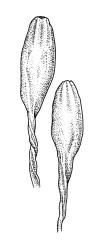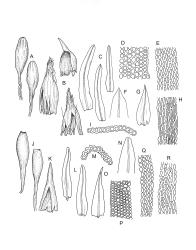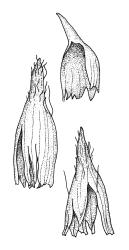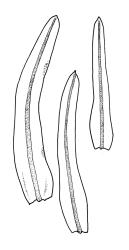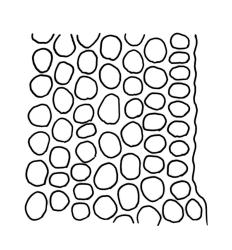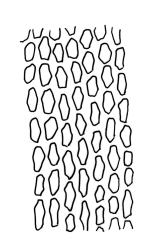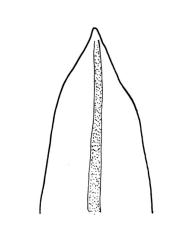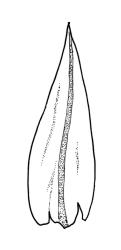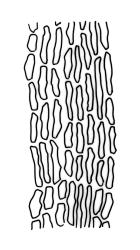Plants slender to medium-sized, dull or lustrous, olive-green above, dark green to dark brown below. Branches to c. 10 mm. Stem leaves flexuose-erect when dry, widely spreading and recurved when moist, broadly to narrowly ovate-lanceolate, obtuse, 1.3–1.5 mm. Branch leaves flexuose-twisted, with upper portion strongly inrolled and apices obscured when dry, flexuose-spreading with weakly inflexed apices when moist, not funiculate, linear-lanceolate to ligulate, rounded-obtuse to broadly acute in N.Z. material, strongly keeled, mostly 1.5–2.5(–3) mm; margins minutely crenulate above, plane to reflexed and entire below; upper laminal cells ± isodiametric and rounded-subquadrate, thin- or firm-walled and with ± thickened corners, strongly bulging, smooth or with 1–4 small papillae, 8–12 µm wide, often slightly oblate in a single row at margins; mid laminal cells ± similar to upper, extending basally with little change far toward the leaf base and then transitioning rapidly into the inner basal cells; inner basal cells rectangular to moderately elongate, 20–33(–50) × c. 8 µm (lumina 2–3 µm wide), thick-walled, scarcely porose, mostly smooth, and extending for up to ¼ the leaf length; marginal basal cells not forming a distinct border. Costa subpercurrent, percurrent, or short-excurrent to form a minute apiculus (variable on single branch), shiny and smooth abaxially with elongate cells exposed (except near apex), in cross-section with 2–3 guide cells and 1–2 rows of abaxial stereids. Gemmae absent.
Pseudautoicous. Perichaetial leaves smaller than adjacent vegetative leaves, ± lanceolate, slenderly acute, 1.3–1.6 mm. Male plants dwarf, axillary, bulbiform. Setae 5–6 mm, smooth, flexuose-erect, slender, sinistrorse; capsules narrowly ovate to elliptic, smooth below, becoming strongly 8-plicate below the dark, constricted, and plicate mouth, 1.4–1.5 mm; exothecial cells moderately thick-walled, irregularly elliptic to short-rectangular, 19–50 × 12–20 µm, darker, mostly short-rectangular or short-elliptic, and forming distinct longitudinal bands at rim; stomata and annulus as per genus; operculum with an erect rostrum. Peristome single, reduced, or absent; exostome when present a low, partially divided, papillose membrane 1–few cells high and very inconspicuous. Calyptra lobed at base, divided by 1–5 long slits and mitrate, or split by one conspicuous slit and ± cucullate, smooth or weakly plicate, naked or with few hairs above. Spores indistinctly anisosporous, 15–25 µm, finely papillose.
Vitt 1983, figs 208–218, 221, 224–225; Vitt & Ramsay 1985, figs 91–97.
The most reliable diagnostic characters distinguishing M. ligulaefolium from its close ally M. ligulare are the sporophytic features cited in the key; in my opinion, sterile material cannot be reliably named.
For those wishing to attempt to name sterile material or to further investigate the relationship between M. ligulaefolium and M. ligulare, Vitt (1983) suggested that most populations of M. ligulaefolium have narrower and more sharply pointed leaves with more variable costa lengths than M. ligulare, and that the inner basal laminal cells of M. ligulaefolium extend further from the leaf insertion (up to c. ¼ the leaf length). These features are indeed observable in some N.Z. collections of M. ligulaefolium, but they do not seem consistent enough to allow for confident determination. Also according to Vitt, plants of M. ligulaefolium have branches rarely exceeding 5 to 10 mm. The total number of N.Z. collections of M. ligulaefolium is very small.
K; NI: N Auckland, including offshore islands (LB), S Auckland (Hākarimata Range),Wellington (Eastbourne).
Australasian. Tasmania*, mainland Australia*.
Little is known about the habitat of this rarely collected species in N.Z. Material has been confirmed from near sea level to 520 m (both on Little Barrier I.) elevation. Confirmed specimens were epiphytic (on Beilschmiedia tawa, Knightia excelsa, Kunzea ericoides, or Prumnopitys ferruginea).
Vitt & Ramsay (1985) documented this species on the Australian east coast from Cairns to Tasmania and considered it to be common or abundant in several parts of its range (including the Sydney–Narooma area and the Blue Mountains of N.S.W.). It grows both as an epiphyte and on rock in Australia. They also recorded the species from New Caledonia and predicted it may be found to be more widespread in Oceania. They placed this species in their "M. ligulare group" with M. ligulare, M. incurvifolium, and two Australian endemic species.



